
Leif Erikson
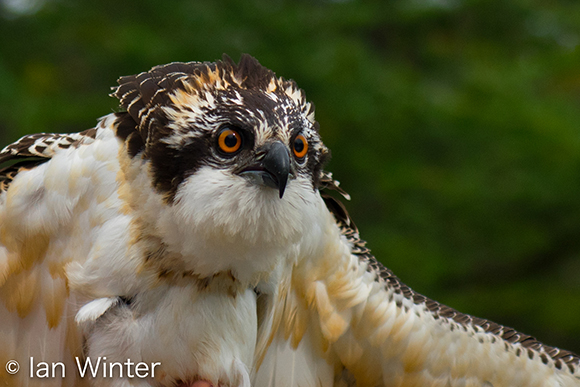 |
Bio - Leif EriksonLeif is a young male hatched at the Memorial University of Newfoundland's Botanical Garden in St. John's, Newfoundland. He was trapped on 25 August, perhaps a week or two after he fledged. He was one of three young produced at this nest this summer. He was named for the viking explorer who landed in Newfoundland about 500 years before Columbus made it to the Caribbean.
Leif's data: Band: 1088-10516 Wing: 44.5 cm Tail: 20.5 cm Weight: 1.36 kg (2.92 lbs) Transmitter: 161873 |
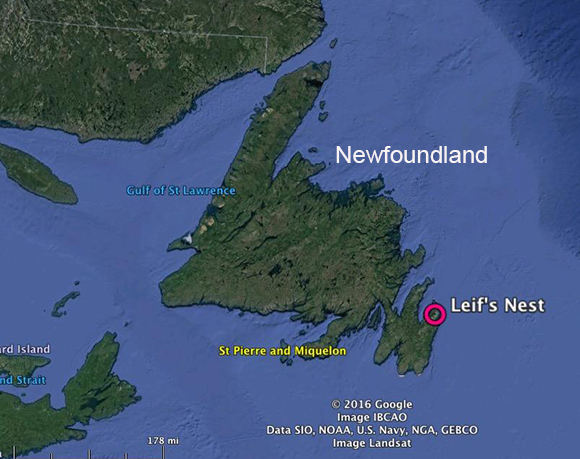 |
Leif's nest...is in a spruce/fir forest at the Municipal University of Newfoundand's Botanical Garden in St. John's, Newfoundland. |
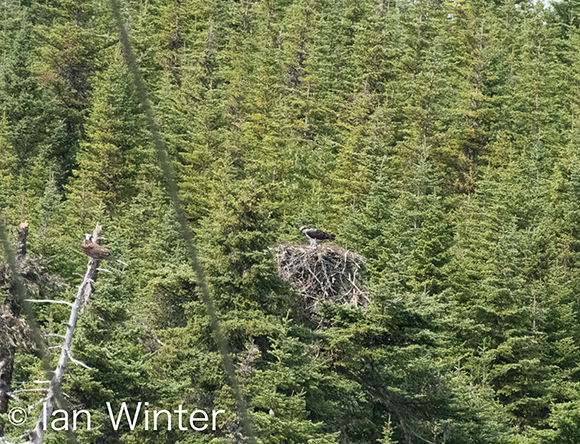 |
Leif's nest...is the first tree nest I've visited to trap Ospreys. |
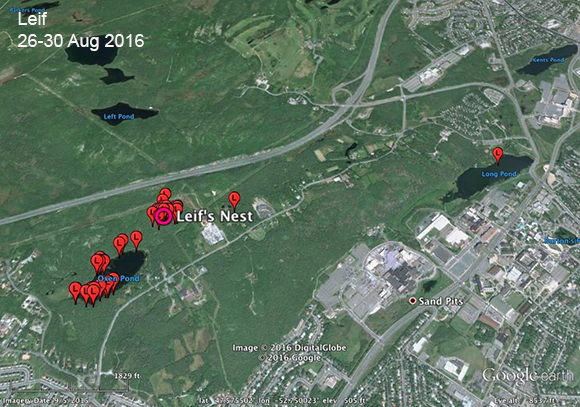 |
26-30 Aug 2016Leif is spending most of his quality water time down at Oxen Pond, but has explored as far east as Long Pond 2.1 km (1.3 mi.) from his nest. |
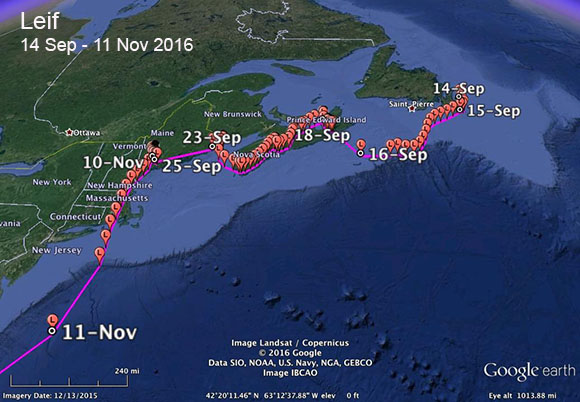 |
14 Sep - 11 Nov 2016Leif began his first migration on 15 Sep, flying due south down Newfoundland's Avalon Peninsula and then headed out over the Atlantic, as we predicted. He then surprised us by turning north and finding Nova Scotia. He may have run into bad weather, which would explain the turn north. Once on land, he worked his way south to the tip of Nova Scotia. At this point, logic dictates that he would have headed south, but of course he flew north. Hard to explain that, unless it was weather related somehow. He landed in Maine and then we lost his signal. It seemed almost certain that he had died, but on the next upload cycle, he turned up in Lewiston, in western Maine. He stayed there for 45 days, and finally restarted his migration on 11 Nov, when most of the other birds were already settled down on their winter ranges. |
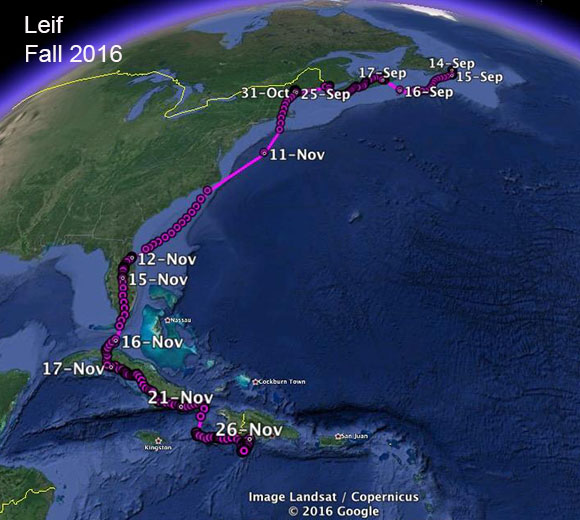 |
14 Sep-26 Nov 2016After his long lay-over in Maine, Leif headed due south. An experienced adult would have gone southwest down the east coast, but young Leif, not knowing any better, got to the coast of southern Massachusetts just west of the famous Westport River Osprey colony (long vacated by all resident Ospreys!). Seeing nothing but water in front of him, he followed his prime directive--go south--and pushed out over the Atlantic Ocean. About 36 hours later, on the evening of the 12th, he arrived in Florida. He moseyed south for the next three days. On the 15th he picked up a tailwind and blew through the rest of southern Florida. After a mysteriously slow crossing of the Florida straights--probably involving some nocturnal rest on a boat (see next panel), he made it to Cuba on the 16th. He kept heading due south until he got to Cuba's Caribbean coast. Then he worked his way down the south shore to the Sierra Madre mountains and flew pretty close to our colleague Freddy Santana's hawk watch at La Gran Piedra. From there is was over Guantanamo and on to Hispaniola. |
 |
16-17 Nov 2016Leif got to Daytona Beach on the evening of the 12th. The next morning, perhaps after a bit of fishing, he was on the wing again by 9:30. He flew about 50 miles to the Orlando area, where he spent the 14th, obviously fishing. On the 15th, he moved another 50 miles south, spending the night near Frostproof, Florida. On the 16th he got back into full migration mode, starting south before 10 AM. At 4 PM he was passing over the Florida Keys (Islamorada), Cuba-bound. Our last GPS fix for the afternoon was at 5 PM out over the Florida Straights. The next location is at midnight, 7 hours later, but only 61 miles south of his 5 PM location. So we're missing something, because Leif can't fly under 9 miles an hour, so he had to have stopped. Then we pick him up again at 5 AM, just 13 miles south of the midnight GPS point. So, where was Leif from 5 PM to 5 AM? The most likely explanation is that he spent some time resting on something--probably a boat--but we don't have enough information to say for sure.
|
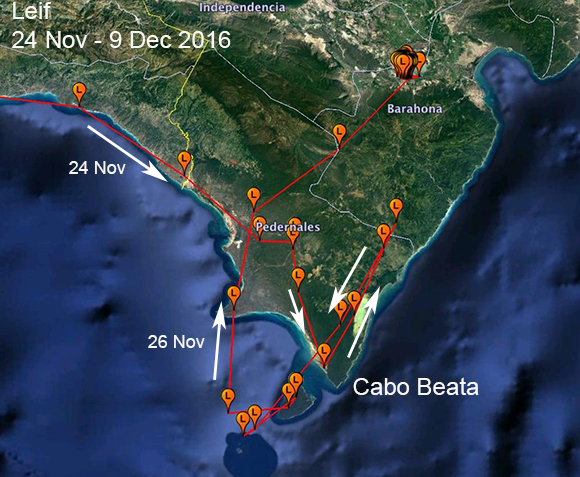 |
24 Nov - 9 Dec 2016Leif cruised across Cuba and on to Haiti and then followed the coast down to Cabo Beata, launching point for 80% of the adult Ospreys traveling to South America. He looked like a pro! Once he to the tip of the cape he wandered north for a few hours and then it looked like he was going to make the Caribbean crossing. But he apparently got cold feet and changed his mind. He turned around and headed north. Once over land again, he moved up to a large lake called Laguna del Rincon. This is one of a series of below-sea-level lakes in a rift valley that runs from Haiti into SW Dominica. We know two of these lakes from following other birds, especially Belle, who stop for refueling at Lakes Azuei and Enriquillo. This looks like a good spot, but we had a bird (Luke) shot here way back in 2011. So it makes me nervous! It's early to call this the end of his migration. |
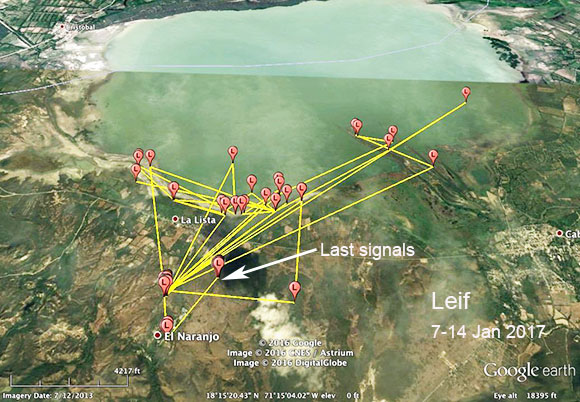 |
7-14 Jan 2017 - Last signalsLeif indeed shut down the migration engine and settled down at Laguna del Rincon in southwestern Dominica. After a couple of weeks there, it became obvious that he wasn't going to continue his migration and cross the Caribbean. He made it to 14 Jan when he became the 5th out of 5 juvenile Osprey that tried to winter in the D.R. to die. We have no idea what happened to him. His last signals were from the side of a road leading to the lake. The road's not near water and too isolated for there to be enough traffic that we might blame this on a vehicular collision (unlike Edwin alongside I-95 in Connecticut last year). He might have been shot by a hunter, but he wasn't near a fish-farm, so we have no firm evidence. There are some wires along the road, so he might have collided with one of them. We can't blame a Great-horned Owl--a prime suspect when an Osprey roosts in a woodlot and doesn't come out the next morning. So this is just an inexplicable loss. There's a chance still that we might find the transmitter. Right now it's not transmitting because the battery has discharged. If a scavenger flips the body and transmitter over, the battery may recharge and we'll get a signal again. This is what happened to Virginia's transmitter down in the marshes of South Carolina. That transmitter's sitting on my windowsill waiting to be redeployed late this summer. This happened with a few other birds, going all the way back to Bunga in 2004. |